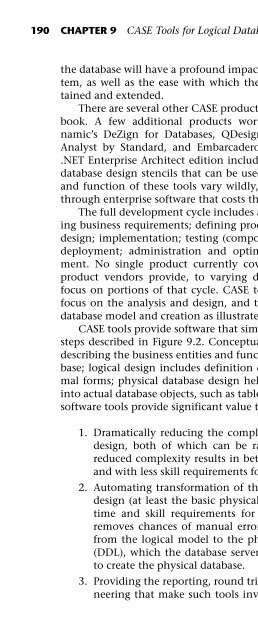Database Modeling and Design
Database Modeling and Design
Database Modeling and Design
You also want an ePaper? Increase the reach of your titles
YUMPU automatically turns print PDFs into web optimized ePapers that Google loves.
190 CHAPTER 9 CASE Tools for Logical <strong>Database</strong> <strong>Design</strong><br />
the database will have a profound impact on the performance of the system,<br />
as well as the ease with which the database system can be maintained<br />
<strong>and</strong> extended.<br />
There are several other CASE products that we will not discuss in this<br />
book. A few additional products worth investigating include Datanamic’s<br />
DeZign for <strong>Database</strong>s, Q<strong>Design</strong>er by Quest Software, Visible<br />
Analyst by St<strong>and</strong>ard, <strong>and</strong> Embarcadero ER/Studio. The Visual Studio<br />
.NET Enterprise Architect edition includes a version of Visio with some<br />
database design stencils that can be used to create ER models. The cost<br />
<strong>and</strong> function of these tools vary wildly, from open source products up<br />
through enterprise software that costs thous<strong>and</strong>s of dollars per license.<br />
The full development cycle includes an iterative cycle of underst<strong>and</strong>ing<br />
business requirements; defining product requirements; analysis <strong>and</strong><br />
design; implementation; testing (component, integration, <strong>and</strong> system);<br />
deployment; administration <strong>and</strong> optimization; <strong>and</strong> change management.<br />
No single product currently covers that entire scope. Instead,<br />
product vendors provide, to varying degrees, suites of products that<br />
focus on portions of that cycle. CASE tools for database design largely<br />
focus on the analysis <strong>and</strong> design, <strong>and</strong> to a lesser degree testing, of the<br />
database model <strong>and</strong> creation as illustrated in Figure 9.2.<br />
CASE tools provide software that simplifies or automates some of the<br />
steps described in Figure 9.2. Conceptual design includes steps such as<br />
describing the business entities <strong>and</strong> functional requirements of the database;<br />
logical design includes definition of entity relationships <strong>and</strong> normal<br />
forms; physical database design helps transform the logical design<br />
into actual database objects, such as tables, indexes, <strong>and</strong> constraints. The<br />
software tools provide significant value to database designers by:<br />
1. Dramatically reducing the complexity of conceptual <strong>and</strong> logical<br />
design, both of which can be rather difficult to do well. This<br />
reduced complexity results in better database design in less time<br />
<strong>and</strong> with less skill requirements for the user.<br />
2. Automating transformation of the logical design to the physical<br />
design (at least the basic physical design). This not only reduces<br />
time <strong>and</strong> skill requirements for the designer, but significantly<br />
removes chances of manual error in performing the conversion<br />
from the logical model to the physical data definition language<br />
(DDL), which the database server will “consume” (i.e., as input)<br />
to create the physical database.<br />
3. Providing the reporting, round trip engineering, <strong>and</strong> reverse engineering<br />
that make such tools invaluable in maintaining systems




